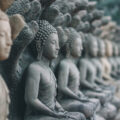Racial identity politics through a Buddhist lens
In this article, our analyst Timo Pieters explores racial identity politics through a Buddhist lens. He uses Buddhist philosophy to question collective guilt, the category of race, and the basis of personal identity. He finally argues for individuality and impartial moral concern.
This article was written by Timo Pieters and reflects his personal analyses and opinions, rather than those of EARS.
Identity politics on the far-right and the far-left
In 2020, in the midst of the coronavirus crisis, we saw protests against racism all over the world, including in Europe.[1] While the story of George Floyd and Black Lives Matter (BLM) acted as a trigger, the scale of the protests showed us how racial identity has become increasingly important in European politics. While the BLM protests were fighting against identity politics on the far-right (i.e. ‘white supremacy’), some protesters seemed to promote a far-left version of identity politics, which is usually called ‘critical race theory’ or ‘intersectionality’. The main premise of this ideology, which emerged during the 1970s in the United States, is that ‘race’ is a social construct that was created to maintain white supremacy and white privilege.[2] [3] It also assumes that racism is exclusively perpetrated by white people, and that it is present in all situations involving white people, regardless of their intentions.[4] It therefore assumes that all white people are racist by default, and that they bear collective guilt for it as a result.[5]
The common ground of group identity
While it may be uncomfortable or taboo to point this out, both versions of identity politics therefore share a common ground, which is their belief in the existence and moral significance of group identity. For white supremacists, the white race is unchanging and pure, and has qualities that are inherently superior to other races. In their eyes, this gives white people the mandate to exercise power over non-white peoples and cultures.[6] Ironically, the far-left version also makes racial groups into solid categories that determine one’s identity, and attributes collective guilt (‘white privilege’) to those who belong to the ‘white’ group.[7] It is therefore interesting to notice that both ‘white supremacy’ and ‘critical race theory’ fit the dictionary definition of racism, namely ‘prejudice, discrimination, or antagonism by an individual, community, or institution against a person or people on the basis of their membership of a particular racial or ethnic group…’[8] For both, group identity is more important than individual identity, because society is seen as a battleground between identity groups with different levels of power.[9]
The Buddha’s critique of collective guilt
Surprisingly, similar attitudes were present during the Buddha’s time, 2,500 years ago. Back then, it was known as the caste system, which still exists in India today. In this system, a person’s moral status is determined by the caste (social class) they happen to be born into.[10] [11] However, the Buddha introduced the revolutionary idea that ‘nobility’ (Sanskrit: arya) was not determined by birth, but by how a person acts, and the virtues they choose to cultivate.[12] This means that one’s group identity does not determine one’s moral worth. It is a familiar sentiment that was also expressed by Martin Luther King, Jr., when he said: “I have a dream that my four little children will one day live in a nation where they will not be judged by the color of their skin, but by the content of their character…”[13]
The illusory category of race
But the Buddha’s scepticism went even deeper. He not only questioned group-based moral judgements, but also the basis of group identity itself. One of his fundamental insights was that we as human beings tend to perceive things as if they exist in impossible ways.[14] One of the ways we do this is by making fixed categories in our minds, and then trying to fit individual things (or people) into those neat little boxes. Categories can be useful, and we need them for communication, but it is quite easy to forget that they are mere conventions that can obscure how things really exist.[15] For example, we tend to think of categories like ‘black’ or ‘white’ as if they are unchanging, and as if they exist separately from the individual people who make up each group. It is as if there is a ‘blackness’ apart from individual black people. We also tend to forget that the existence of the group depends on us mentally labelling it as a group.[16] This is proven by the fact that, prior to the 16th century, the concept of ‘race’ did not even exist, because people mostly thought that physical differences between people were due to environmental factors, rather than heritability.[17] Therefore, if we try to find the ‘thing’ that the concept of ‘black’ (or ‘white’) refers to, we cannot find anything solid.[18] It dissolves under analysis.
Race and personal identity
To imagine that racial categories actually exist is one thing, but to then identify with them is another. The Buddha claimed to have discovered that the process of identification is the root cause of our psychological suffering. We tend to identify with certain aspects of our body and mind as if they are inherently ‘me’ or ‘mine’, while they are actually not. When the Buddha tried to find his ‘self’, he failed to find anything besides various bodily and mental processes. He could not find anything about a thought or sensation that made it inherently ‘me’.[19] I would argue that the same is true with skin colour. It does not have the power to establish our identity (make me ‘me’), all by itself. Most of us do not feel that our identity is determined by our hair colour or eye colour, so we could feel the same way about the tone of our skin.[20] Take the example of a ‘black’ and a ‘white’ person having a baby together. Is the baby now black or white? Logically speaking, both answers could be equally valid. Due to the science of genetics we now know that there is no biological basis for our rigid categories of race. As an article from Harvard Medical School put it, ‘there is no evidence that the groups we commonly call “races” have distinct, unifying genetic identities.’[21] The DNA of all human beings is 99.9% identical, leaving 0.1% to explain all the variation we see. This can lead to strange consequences, such as two European people being more genetically similar to an Asian person than they are to each other.[22]
Individuality and moral circle expansion
Ironically, if you take the idea of intersectionality to its logical conclusion, you end up with individuality, because each individual would have a unique combination of group identities.[23] One could therefore say that the individual is the ultimate minority. Buddhist ethics seems to be based on expanding our moral circle to include not only all human beings, but also other biological species, which allows us to transcend the limits of racism, sexism, and speciesism (discrimination based on species). It therefore seems likely that the Buddha envisioned a moral future where such group identities do not determine anyone’s moral worth or guilt.
We might therefore ask ourselves whether such a future could be gained by focusing more and more on race. Can something become less significant by making it more significant? The far-right and far-left versions of racial identity politics seem to keep reinforcing each other, precisely because they are based on the same illusions of race and inherent group identity, which stimulate our tribalism. If we want to break this cycle, and actually eliminate racism, as I think we should, then it cannot be accomplished by engaging in more (reverse) racism.[24] This is not only counterproductive, but also morally unacceptable. Only when our actions are no longer based on misunderstandings can we reliably produce the changes we would like to see in the world. As the 7th-century Buddhist philosopher Dharmakirti said, “The accomplishment of all human aims is preceded by right knowledge.”[25]
This article was written by Timo Pieters and reflects his personal analyses and opinions, rather than those of EARS.
Interested in similar topics? Go to our Dashboard and receive free updates.
[1] George Floyd police killing fuels racism protests in London, Berlin, Brussels, Rome, Madrid.
[2] Helen Pluckrose and James Lindsay, Cynical Theories (Pitchstone Publishing: Durham, North Carolina, 2020), Kindle edition, Location 1777.
[3] Now, of course, critical race theory is a multifaceted intellectual movement that is concerned with the relationship between race, racism and power. It is famous for questioning the foundations of liberalism. See for example: Richard Delgado, Jean Stefancic, and Angela Harris, Critical Race Theory: An Introduction (New York, 2017), p. 3.
[4] Heather Bruce, Robin DiAngelo, Gyda Swaney (Salish), and Amie Thurber, “Between Principles and Practice: Tensions in Anti-Racist Education” (panel, 2014 Race & Pedagogy National Conference, University of Puget Sound), video posted by Collins Memorial Library, vimeo.com/116986053. Minutes 3:09 – 5:03.
[5] Pluckrose and Lindsay, Cynical Theories, Kindle edition, Loc. 1953-1961 and 3430.
[6] Pluckrose and Lindsay, Cynical Theories, Kindle edition, Loc. 4332. This usually also goes together with sexist and homophobic attitudes.
[7] As Kimberlé Crenshaw says in her paper ‘Mapping the Margins’ (p. 1297): ‘“I am Black” takes the socially imposed identity and empowers it as an anchor of subjectivity. “I am Black” becomes not simply a statement of resistance but also a positive discourse of self-identification, intimately linked to celebratory statements like the Black nationalist “Black is beautiful.”’ This quote shows how viewing race as a social construct does not necessarily mean that one sees the categories of race as illusory, or that one no longer identifies with those categories.
[8] RACISM | Definition of RACISM by Oxford Dictionary on Lexico.com also meaning of RACISM.
[9] Pluckrose and Lindsay, Cynical Theories, Kindle edition, Loc 3003. This view of human society is central to postmodernism, which laid the groundwork for ‘critical race theory’ and later ‘intersectionality’.
[10] Race – India’s caste system.
[11] History of the Caste System in India.
[12] The Nobility of the Truths, end of second paragraph.
[13] “I Have a Dream,” Address Delivered at the March on Washington for Jobs and Freedom.
[14] According to the Consequentialist Centrist (Prasangika Madhyamaka) tradition, we tend to perceive things as (1) static (unaffected), (2) monolithic (partless), (3) independent, (4) knowable all by itself, and (5) self-established (as if they establish their own existence, independent of anything else). The Coarse and Subtle Impossible “Me’s” — Study Buddhism.
[15] Syntheses, Categories and Individual Items — Study Buddhism.
[16] Establishing the Existence of Validly Knowable Objects.
[17] Pluckrose and Lindsay, Cynical Theories, Kindle edition, Loc. 1796.
[18] Establishing the Existence of Validly Knowable Objects.
[19] B. Alan Wallace, Minding Closely: The Four Applications of Mindfulness (Snow Lion, 2011), p. 40-41.
[20] Even if one interprets ‘black’ as a sociological or cultural group instead of a biological group, one’s membership in that sociological group would still be based on the physical marker of one’s skin colour. One therefore still indirectly identifies with one’s skin colour.
[21] How Science and Genetics are Reshaping the Race Debate of the 21st Century.
[22] Ibid. Ironically, the genetic variation within one ethnic population is usually greater than between different ethnic populations.
[23] Pluckrose and Lindsay, Cynical Theories, Kindle edition, Loc. 823. Intersectionality developed out of critical race theory, and was popularised by Kimberle Crenshaw.
[24] This includes any racist behaviour by individuals or institutions.
[25] Quote from his ‘Drop of Reasoning’ (Nyayabindu). Christian Coseru, Perceiving Reality: Consciousness, Intentionality, and Cognition in Buddhist Philosophy (New York: Oxford University Press, 2012), p. 128 (note 11).






